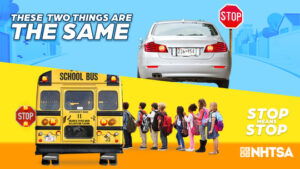
The patrols are part of the Stop Arm Violation Enforcement campaign – better known as SAVE. These patrols are funded by the National Highway Traffic Safety Administration (NHTSA) through grants administered by the Indiana Criminal Justice Institute (ICJI).
Despite thousands of motorists being cited under the SAVE program, unsafe driving around school buses continues to be a serious danger to children, according to the National Association of State Directors of Pupil Transportation Services (NASDPTS).
In April, thousands of bus drivers who participated in a one-day observational survey counted 1,574 stop-arm violations in Indiana. Projected across a 180-day school year, this survey data points to a potential 283,320 violations throughout the school year.
The data comes from the NASDPTS annual survey, which is managed by the Indiana Department of Education for the state of Indiana. This year, data collection took place on April 23, with 4,910 bus drivers participating.
“There is no excuse for drivers to put the lives of students in danger,” said ICJI Traffic Safety Director James Bryan. “Drivers need to exercise caution around school buses and follow all traffic statutes.”
To prevent unsafe driving, officers will use a range of enforcement strategies from high-visibility patrols to police spotters on buses. For each jurisdiction, officers will coordinate with local bus drivers and school transportation officials, with efforts concentrating in the morning and afternoon hours. Agencies will also be working to raise awareness about the importance of school bus safety and following the law.
Drivers should slow down and prepare to stop when the overhead lights on a school bus are flashing yellow. Once the lights turn red and the stop arm extends, drivers are required to stop on all roads with only one exception. On highways divided by a physical barrier, such as a concrete wall or grassy median, only vehicles traveling in the same direction as the school bus are required to stop in these circumstances.
Motorists should also be mindful of posted speed limits, avoid distractions, and watch for children in, or near, school and residential areas. Planning ahead and allowing for extra time during each commute will help keep all road users safe.
(Indiana Criminal Justice Institute press release)



